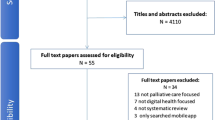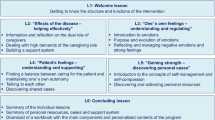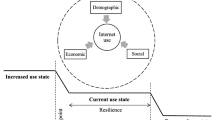Abstract
The Internet is a valuable tool that continues to revolutionize many aspects of our lives; however, the ability to disseminate diverse data across populations and nations presents both opportunities and challenges. Online resources are increasingly used in health care, providing wider access to information for patients, researchers, and clinicians. At the turn of the millennium, the National Cancer Institute (NCI) predicted that Internet-based technologies would create a revolution in communication for oncology professionals and patients with cancer. Herein, findings from the NCI's Health Information National Trends Survey are reviewed to give insight into how Internet trends related to oncology patients are evolving. Future trends are discussed, including examples of 'connected health' in oncology; the spread of mobile and ubiquitous access points to Internet-hosted information; the diffusion of devices, sensors, and apps; the spread of personal data sharing; and an evolution in how networks can support person-centred and family-centred care.
This is a preview of subscription content, access via your institution
Access options
Subscribe to this journal
Receive 12 print issues and online access
$209.00 per year
only $17.42 per issue
Buy this article
- Purchase on Springer Link
- Instant access to full article PDF
Prices may be subject to local taxes which are calculated during checkout




Similar content being viewed by others
References
National Cancer Institute. The nation's investment in cancer research: a budget proposal for fiscal year 2000 (U.S. Department of Health & Human Services, 1999).
National Committee on Vital and Health Statistics. Information for health: a strategy for building the national health information infrastructure (U.S. Department of Health & Human Services, 2001).
Eng, T. R., Gustafson, D. H. & Science Panel on Interactive Communication and Health. Wired for health and well-being: the emergence of interactive health communication (U.S. Department of Health & Human Services, 1999).
Helft, P. R., Hlubocky, F. & Daugherty, C. K. American oncologists' views of internet use by cancer patients: a mail survey of American Society of Clinical Oncology members. J. Clin. Oncol. 21, 942–947 (2003).
Berland, G. K. et al. Health information on the Internet: accessibility, quality, and readability in English and Spanish. JAMA 285, 2612–2621 (2001).
Kreps, G. L. et al. The NCI Digital Divide Pilot Projects: implications for cancer education. J. Cancer Educ. 22, S56–S60 (2007).
Fredericks, M., Odiet, J. A., Miller, S. I. & Fredericks, J. Toward a conceptual reexamination of the patient–physician relationship in the healthcare institution for the new millennium. J. Natl Med. Assoc. 98, 378–385 (2006).
Patrick, K., Intille, S. S. & Zabinski, M. F. An ecological framework for cancer communication: implications for research. J. Med. Internet Res. 7, e23 (2005).
Hesse, B. W. Harnessing the power of an intelligent health environment in cancer control. Studies Health Technol. Inform. 118, 159–176 (2005).
Silva, J. S. Cancer Informatics: Essential Technologies for Clinical Trials (Springer, 2002).
Viswanath, K. Science and society: the communications revolution and cancer control. Nat. Rev. Cancer 5, 828–835 (2005).
Schwarts, L. M., Woloshin, S. & Welch, H. G. Risk communication in clinical practice: putting cancer in context. J. Natl Cancer Inst. Monogr. 1999, 124–133 (1999).
National Cancer Institute. The nation's investment in cancer research: a budget proposal for fiscal year 2001 (U.S. Department of Health & Human Services, 2000).
Nelson, D. E. et al. The Health Information National Trends Survey (HINTS): development, design, and dissemination. J. Health Commun. 9, 443–460; discussion 481–444 (2004).
Shannon-Missal, L. Majorities of Americans and Canadians Expect to See a Cure for Cancer in Their Lifetime. http://www.theharrispoll.com/health-and-life/Majorities_Expect_Cure_for_Cancer.html (2016).
Boyer, C., Baujard, V., Scherrer, J. R. & Appel, R. D. HON's Third survey on the usage of the Internet for medical & health Internet purposes. https://www.hon.ch/Library/PapersHON/mednet_survey_mai98.html (1998).
Pew Internet and American Life Project. Three Technology Revolutions. http://pewinternet.org/Trend-Data-(Adults)/Internet-Adoption.aspx (2012).
Rice, R. E. in The Internet and Health Communication: Experiences and Expectations (eds Rice, R. E. & Katz, J. E.) 5–46 (Sage, 2001).
Finney Rutten, L. J., Blake, K., Moser, R. P. & Hesse, B. W. Partners in progress: informing the science and practice of health communication through national surveillance. J. Health Commun. 15, 3–4 (2010).
Finney Rutten, L. J., Hesse, B. W., Moser, R. P. & Kreps, G. L. Building the Evidence Base in Cancer Communication (Hampton Press, 2010).
Finney Rutten, L. J. et al. Picking up the pace: changes in method and frame for the health information national trends survey (2011–2014). J. Health Commun. 17, 979–989 (2012).
Fox, S. & Rainie, L. Vital Decisions: How Internet Users Decide What Information to Trust When They or Their Loved Ones Are Sick (Pew Research Center, 2002).
Rose, D. Enchanted Objects: Design, Human Desire, and the Internet of Things (Scribner Book Company, 2014).
Hesse, B. W. et al. Meeting the healthy people 2020 goals: using the Health Information National Trends Survey to monitor progress on health communication objectives. J. Health Commun. 19, 1497–1509 (2014).
Hambelton, K. The millennial effect: a generation changing healthcare technology. evariant http://www.evariant.com/blog/the-millennial-effect-a-generation-changing-healthcare-technology (2015).
Wachter, R. M. The Digital Doctor: Hope, Hype, and Harm at the Dawn of Medicine's Computer Age (McGraw-Hill Education, 2015).
Anthony, D. L. & Campos-Castillo, C. A looming digital divide? Group differences in the perceived importance of electronic health records. Inform. Commun. Soc. 18, 832–846 (2015).
Cutrona, S. L. et al. Health information-seeking on behalf of others: characteristics of 'surrogate seekers'. J. Cancer Educ. 30, 12–19 (2015).
Miller, S. M., Bowen, D. J., Croyle, R. T. & Rowland, J. H. Handbook of Cancer Control and Behavioral Science: A Resource for Researchers, Practitioners, and Policymakers (American Psychological Association, 2009).
Gruman, J. C. Making health information technology sing for people with chronic conditions. Am. J. Prev. Med. 40, S238–S240 (2011).
Hesse, B. W. et al. Trust and sources of health information: the impact of the Internet and its implications for health care providers: findings from the first Health Information National Trends Survey. Arch. Intern. Med. 165, 2618–2624 (2005).
Hesse, B. W. The Patient, the Physician, and Dr. Google. Virtual Mentor 14, 398–402 (2012).
Hesse, B. W., Moser, R. P. & Rutten, L. J. Surveys of physicians and electronic health information. N. Engl. J. Med. 362, 859–860 (2010).
Grewal, P. & Alagaratnam, S. The quality and readability of colorectal cancer information on the Internet. Int. J. Surg. 11, 410–413 (2013).
So, J. et al. What do people like to 'share' about obesity? A content analysis of frequent retweets about obesity on twitter. Health Commun. 31, 193–206 (2016).
Abramson, K., Keefe, B. & Chou, W. Y. Communicating about cancer through Facebook: a qualitative analysis of a breast cancer awareness page. J. Health Commun. 20, 237–243 (2015).
Cole, J., Watkins, C. & Kleine, D. Health advice from Internet discussion forums: how bad is dangerous? J. Med. Internet Res. 18, e4 (2016).
Crocco, A. G., Villasis-Keever, M. & Jadad, A. R. Analysis of cases of harm associated with use of health information on the internet. JAMA 287, 2869–2871 (2002).
Nolke, L., Mensing, M., Kramer, A. & Hornberg, C. Sociodemographic and health-(care-)related characteristics of online health information seekers: a cross-sectional German study. BMC Publ. Health 15, 31 (2015).
Eysenbach, G. From intermediation to disintermediation and apomediation: new models for consumers to access and assess the credibility of health information in the age of Web2.0. Stud. Health Technol. Inform. 129, 162–166 (2007).
Kemper, D. W. & Mettler, M. Information Therapy: Prescribed Information as a Reimbursable Medical Service 1st edn (Healthwise, 2002).
McKnight, M. Information prescriptions, 1930–2013: an international history and comprehensive review. J. Med. Libr. Assoc. 10, 271–280 (2014).
Hewitt, M. E. & Ganz, P. A. From Cancer Patient to Cancer Survivor: Lost in Transition: an American Society of Clinical Oncology and Institute of Medicine Symposium (National Academies Press, 2006).
Finney Rutten, L. J. et al. Cancer-related information seeking among cancer survivors: trends over a decade (2003–2013). J. Cancer Educ. 31, 348–357 (2015).
Tennant, B. et al. eHealth literacy and Web 2.0 health information seeking behaviors among baby boomers and older adults. J. Med. Internet Res. 17, e70 (2015).
Prestin, A., Vieux, S. N. & Chou, W.-Y. Is online health activity alive and well or flatlining? Findings from 10 years of the Health Information National Trends Survey. J. Health Commun. 4, 1–9 (2015).
Rimer, B. K. et al. How new subscribers use cancer-related online mailing lists. J. Med. Internet Res. 7, e32 (2005).
Chou, W. Y., Hunt, Y., Folkers, A. & Augustson, E. Cancer survivorship in the age of YouTube and social media: a narrative analysis. J. Med. Internet Res. 13, e7 (2011).
Chou, W. Y., Hunt, Y. M., Beckjord, E. B., Moser, R. P. & Hesse, B. W. Social media use in the United States: implications for health communication. J. Med. Internet Res. 11, e48 (2009).
Fox, S. & Rainie, L. The Web at 25 in the U.S. (Pew Research Center, 2014).
Rutten, L. F., Hesse, B. W., Moser, R. P. & Kreps, G. L. in Health Communication (ed. Kreps, G. L.) 1–359 (Hampton Press, 2009).
Blumenthal, D. & Tavenner, M. The 'meaningful use' regulation for electronic health records. N. Engl. J. Med. 363, 501–504 (2010).
Irizarry, T., DeVito Dabbs, A. & Curran, C. R. Patient portals and patient engagement: a state of the science review. J. Med. Internet Res. 17, e148 (2015).
Goldzweig, C. et al. Systematic review: secure messaging between providers and patients, and patients' access to their own medical record. Evidence on health outcomes, satisfaction, efficiency and attitudes (Department of Veteran's Affairs, 2012).
Carayon, P., Hoonakker, P., Cartmill, R. & Hassol, A. Using health information technology (IT) in practice redesign: impact of health IT on workflow (Agency for Healthcare Research and Quality, 2015).
Chen, C., Garrido, T., Chock, D., Okawa, G. & Liang, L. The Kaiser Permanente Electronic Health Record: transforming and streamlining modalities of care. Health Aff. (Millwood) 28, 323–333 (2009).
Katzen, C., Solan, M. J. & Dicker, A. P. E-mail and oncology: a survey of radiation oncology patients and their attitudes to a new generation of health communication. Prostate Cancer Prostatic Dis. 8, 189–193 (2005).
Schickedanz, A. et al. Access, interest, and attitudes toward electronic communication for health care among patients in the medical safety net. J. Gen. Intern. Med. 28, 914–920 (2013).
Ancker, J. S. et al. Use of an electronic patient portal among disadvantaged populations. J. Gen. Intern. Med. 26, 1117–1123 (2011).
Lombardo, N. T., Morrow, A. & Le Ber, J. Rethinking mobile delivery: using Quick Response codes to access information at the point of need. Med. Ref. Serv. Q. 31, 14–24 (2012).
Jamwal, N. R. & Kumar, S. P. Smarter palliative care for cancer: use of smartphone applications. Indian J. Palliat. Care 22, 108–110 (2016).
Kourosh, A. S. & Kvedar, J. C. Making mobile health measure up. JAMA Dermatol. 151, 481–482 (2015).
Steinhubl, S. R., Muse, E. D. & Topol, E. J. The emerging field of mobile health. Science Transl. Med. 7, 283rv283 (2015).
Peterson, S. K. et al. Identifying early dehydration risk with home-based sensors during radiation treatment: a feasibility study on patients with head and neck cancer. J. Natl Cancer Inst. Monogr. 2013, 162–168 (2013).
Amobi, A. & Nekhlyudov, L. Cancer care at your fingertips: mobile applications across the cancer care continuum in ASCOConnection 32–35 (American Society of Clinical Oncology, 2015).
Serrano, K. J. et al. Willingness to exchange health information via mobile devices: findings from a population-based survey. Ann. Fam. Med. 14, 34–40 (2016).
Miniwatts Marketing Group. Internet usage statistics. Internet World Stats http://www.internetworldstats.com/stats.htm (2016).
American Society of Clinical Oncology. Accelerating progress against cancer: ASCO's blueprint for transforming clinical and translational cancer research (American Society of Clinical Oncology, 2011).
Olsen, L., Aisner, D. & McGinnis, J. M. IOM Roundtable on Evidence-Based Medicine: The Learning Healthcare System: Workshop Summary (National Academies Press, 2007).
Frist, W. H. Connected health and the rise of the patient-consumer. Health Aff. (Millwood) 33, 191–193 (2014).
Kvedar, J., Coye, M. J. & Everett, W. Connected health: a review of technologies and strategies to improve patient care with telemedicine and telehealth. Health Aff. (Millwood) 33, 194–199 (2014).
Berwick, D. M., Feeley, D. & Loehrer, S. Change from the inside out: health care leaders taking the helm. JAMA 313, 1707–1708 (2015).
Kvedar, J. C., Herzlinger, R., Holt, M. & Sanders, J. H. Connected health as a lever for healthcare reform: dialogue with featured speakers from the 5th Annual Connected Health Symposium. Telemed. J. E. Health 15, 312–319 (2009).
Hibbard, J. H., Greene, J. & Overton, V. Patients with lower activation associated with higher costs; delivery systems should know their patients' 'scores'. Health Aff. (Millwood) 32, 216–222 (2013).
Bashshur, R. L., Shannon, G. W., Tejasvi, T., Kvedar, J. C. & Gates, M. The empirical foundations of teledermatology: a review of the research evidence. Telemed. J. E Health 21, 953–979 (2015).
Kvedar, J. C., Fogel, A. L., Elenko, E. & Zohar, D. Digital medicine's march on chronic disease. Nat. Biotechnol. 34, 239–246 (2016).
Levit, L. A., Balogh, E., Nass, S. J. & Ganz, P. Delivering High-Quality Cancer Care: Charting a New Course for a System Crisis (National Academies Press, 2013).
Rimer, B. K., Witte, O. & Harper, H. Connected health: improving patients' engagement and activation for cancer-related health outcomes. National Cancer Institute http://deainfo.nci.nih.gov/advisory/pcp/glance/ConnectedHealth14-15.pdf (2015).
Moreno-Ramirez, D. & Ferrandiz, L. A. 10-year history of teledermatology for skin cancer management. JAMA Dermatol. 151, 1289–1290 (2015).
Buchanan, A. H. et al. Randomized trial of telegenetics versus in-person cancer genetic counseling: cost, patient satisfaction and attendance. J. Genet. Couns. 24, 961–970 (2015).
Hilgart, J. S., Hayward, J. A., Coles, B. & Iredale, R. Telegenetics: a systematic review of telemedicine in genetics services. Genet. Med. 14, 765–776 (2012).
Krishnan, N., Fagerlin, A. & Skolarus, T. A. Rethinking patient–physician communication of biopsy results — the waiting game. JAMA Oncol. 1, 1025–1026 (2015).
Purnell, C. A. & Arnold, R. M. Retrospective analysis of communication with patients undergoing radiological breast biopsy. J. Support. Oncol. 8, 259–263 (2010).
Lopez, A. M. et al. Virtual slide telepathology enables an innovative telehealth rapid breast care clinic. Hum. Pathol. 40, 1082–1091 (2009).
Klasnja, P. et al. Microrandomized trials: an experimental design for developing just-in-time adaptive interventions. Health Psychol. 34 (Suppl.), 1220–1228 (2015).
Thomas, J. G. & Bond, D. S. Behavioral response to a just-in-time adaptive intervention (JITAI) to reduce sedentary behavior in obese adults: implications for JITAI optimization. Health Psychol. 34 (Suppl.), 1261–1267 (2015).
Basch, E. et al. Symptom monitoring with patient-reported outcomes during routine cancer treatment: a randomized controlled trial. J. Clin. Oncol. 34, 557–565 (2016).
DuBenske, L. L., Chih, M. Y., Dinauer, S., Gustafson, D. H. & Cleary, J. F. Development and implementation of a clinician reporting system for advanced stage cancer: initial lessons learned. J. Am. Med. Inform. Assoc. 15, 679–686 (2008).
Kvedar, J. C., Colman, C. & Cella, G. The Internet of Healthy Things (Partners HealthCare Connected Health, 2015).
Gay, V. & Leijdekkers, P. Bringing health and fitness data together for connected health care: mobile apps as enablers of interoperability. J. Med. Internet Res. 17, e260 (2015).
Kumar, S. et al. Center of excellence for mobile sensor data-to-knowledge (MD2K). J. Am. Med. Inform. Assoc. 22, 1137–1142 (2015).
Comstock, J. Cedars-Sinai to use Fitbits in small trial of cancer patients. MobiHealthNews http://www.mobihealthnews.com/content/cedars-sinai-use-fitbits-small-trial-cancer-patients (2016).
Precision Medicine Initiative Working Group. The Precision Medicine Initiative Cohort Program — building a research foundation for 21st century medicine (National Institutes of Health, 2015).
Arora, N. K. Patient engagement in a rapidly changing communication environment: reflections of a cancer survivor. J. Natl Cancer Inst. Monogr. 2013, 231–232 (2013).
deBronkart, D. & Walker, J. Open visit notes: a patient's perspective and expanding national experience. J. Oncol. Pract. 11, 287–288 (2015).
Follett, R. & Strezov, V. An analysis of citizen science based research: usage and publication patterns. PLoS ONE 10, e0143687 (2015).
Institute of Medicine. Patients Charting the Course: Citizen Engagement and the Learning Health System: Workshop Summary (National Academies Press, 2011).
Campbell, K. R. An apple a day: changing medicine through technology and engagement. Future Cardiol. 11, 259–260 (2015).
Friend, S. H., Ganz, P. A., Schmitz, K. & Partridge, A. H. Share the journey: mind, body, and wellness after breast cancer. Share The Journey http://sharethejourneyapp.org/ (2015).
Hesse, B. W., Hanna, C., Massett, H. A. & Hesse, N. K. Outside the box: will information technology be a viable intervention to improve the quality of cancer care? J. Natl Cancer Inst. Monogr. 2010, 81–89 (2010).
Epstein, R. & Street, R. L. Jr. Patient-centered communication in cancer care: promoting healing and reducing suffering. (National Cancer Institute, 2007).
Stead, W. W. & Lin, H. S. Computational technology for effective health care: immediate steps and strategic directions. (National Academies Press, 2009).
Hesse, B. W. et al. Social participation in health 2.0. Computer (Long Beach Calif.) 43, 45–52 (2010).
Acknowledgements
The work of B.W.H., A.J.G., and L.J.F.R. is supported by the NIH National Cancer Institute. A.J.G. was supported by the Cancer Prevention Fellowship at the National Cancer Institute.
Author information
Authors and Affiliations
Contributions
B.W.H. wrote the manuscript. All authors made substantial contributions to researching the data for the article and to discussions of the content, and reviewed and/or edited the manuscript before submission.
Corresponding author
Ethics declarations
Competing interests
The authors declare no competing financial interests.
Related links
Rights and permissions
About this article
Cite this article
Hesse, B., Greenberg, A. & Rutten, L. The role of Internet resources in clinical oncology: promises and challenges. Nat Rev Clin Oncol 13, 767–776 (2016). https://doi.org/10.1038/nrclinonc.2016.78
Published:
Issue Date:
DOI: https://doi.org/10.1038/nrclinonc.2016.78
This article is cited by
-
Investigation of the Readability and Reliability of Online Health Information for Cancer Patients During the Coronavirus Pandemic
Journal of Cancer Education (2023)
-
Adapting systematic scoping study methods to identify cancer-specific physical activity opportunities in Ontario, Canada
Systematic Reviews (2022)
-
Bladder Cancer and Google Trends: Associations Between US Search Patterns and Disease Outcomes May Show Need for Improved Awareness Strategies
Journal of Cancer Education (2021)
-
Internet and social media use in cancer patients: association with distress and perceived benefits and limitations
Supportive Care in Cancer (2021)
-
Feasibility, acceptability, and efficacy of online supportive care for individuals living with and beyond lung cancer: a systematic review
Supportive Care in Cancer (2021)



